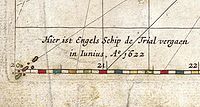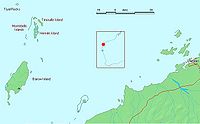Tryall
The Tryall (also spelt Tryal and Trial ) was a British East India Company owned East Indiaman of approximately 500 tons . She was under the command of John Brooke when she was wrecked on the Tryal Rocks off the north-west coast of Western Australia in 1622. Her crew were the first Englishmen to sight Australia and the wreck is Australia's oldest shipwreck, perhaps except for the Mahogany Ship.
Contents
Her final voyage
The ship departed Plymouth on her maiden voyage for Batavia on 4 September 1621, carrying a cargo that included silver for trade in the East Indies as well as a gift for the King of Siam. She stopped at Cape Town for supplies. The East India Company had only recently issued orders requiring that its ships sail south of 32°S when en-route to the East Indies, as this course made use of the so-called roaring forties and could save up to six months travel time off the more traditional northern route.
Neither Brooke nor any of his crew had sailed via the new southern route previously, or even to Batavia, and they asked in Cape Town for experienced sailors willing to join their crew. Thomas Bright was subsequently recruited off the Charles (1000 tons) as first mate.
The vessel departed on 19 March 1622 and sighted the Australian coast on 1 May 1622, apparently mistaking Point Cloates[1] off North West Cape on the mainland for an island that Captain Lenaert Jacobszoon and supercargo Willem Janszoon (captain of the Duyfken in 1603) in the Dutch East India Company ship Mauritius had encounterd in 1618 and which is now known as Barrow Island. This navigation error was caused by having sailed too far east, against the ship's owners explicit instructions.
Wreck


Turning north, they then encountered several weeks of fresh north to north-westerly winds which impeded progress. Finally, the winds turned to favourable south-westerlies and they started to make good progress to their destination of Batavia. On 25 May 1622 at between 10 and 11pm she struck uncharted submerged rocks about 32 km (20 miles) north-west of the outer edge of the Montebello Islands group, the southern boundary of which is about 8 km (5 miles) north of the northern tip of Barrow Island.
The reef is named Tryal Rocks after the ship and is located at 20°16′51″S 115°23′34″E / 20.28083°S 115.39278°E (-20.2809, 115.3929).[2]
Captain Brooke, his son John and nine men scrambled into a skiff and Thomas Bright and 35 others managed to save a longboat. The two boats sailed for Batavia separately. The skiff arrived there on 5 July 1622 and the longboat three days later — a voyage of over 1,800 km (1,120 miles). Of the 143 men who had left England, 93 perished at the wreck site,[2] and one person died in the skiff.
Investigation
On his arrival in Batavia, Brooke wrote to his masters in London blaming Captain Fitzherbert, who had been the first British captain to pioneer the southern route across the Indian Ocean after Dutch captain Hendrik Brouwer. Brooke declared that he had followed the route specified by Fitzherbert and had struck rocks where Fitzherbert had said there were none. He said Fitzherbert's incorrect mapping had been the cause for the disaster and denied any responsibility. Brooke claimed that the reef site was well west of the actual site in an attempt to hide his easterly course. He also claimed that all the cargo, including the silver and the ship's papers, had gone down with the ship when it broke up and sank at about 2am.
Thomas Bright secretly and separately wrote to London. He directly blamed Brooke for the loss of the ship and her crew, blaming Brooke's poor navigation and his failure to post a lookout. He said that after striking the reef, Brooke had hurriedly abandoned the ship and fled into the skiff. According to Bright, Brooke had departed the site immediately, leaving many men in the water to drown though the skiff had room for additional men. Bright's longboat was full to capacity and stood about a quarter mile off the wreck due to the danger of capsizing if any of the men in the water attempted to climb on board. He further contradicted Brooke by stating the ship had not sunk until mid-morning the following day.
Subsequent analysis of these reports and other documents, as well as searches of the wreck site, have raised suspicions that Brooke had secretly removed at least part of the silver into the skiff before the ship sank, and had managed to get it to Batavia without telling anyone.
John Brooke's later career
After he returned to London, Captain Brooke was given the command of another British East India Company ship, the Moone. The ship was wrecked off the coast of Dover, apparently deliberately. A two-year court case, during which Brooke was imprisoned, ended with the case being dropped.[3]
Discovery
The wreck of the Tryall was not located until 1969, after researchers John MacPherson and Eric Christiansen determined the site after the discovery of Thomas Bright's letter and despite the confusion of records left by Captain Brooke.[4] When an exploration team went to the area Christiansen predicted as being the likely site, diver Naoom Haimson almost immediately found the wreck.
Shortly after the discovery, Ellis Alfred (Alan) Robinson, who was unaffiliated with the search team, attempted an illegal salvage operation to uncover the lost treasure through the use of explosives. Robinson failed to recover anything of value and badly damaged the wreck site. He had been involved in an earlier and similar operation involving the Vergulde Draeck wreck near Kalbarri, and in other salvage attempts. Robinson was charged for crimes against the Maritime Archaeology Act and while in prison hanged himself. After his arrest, Robinson became known in the local press as the "the gelignite buccaneer"; his actions led to increased penalties for illegal maritime salvage work.
Divers from the Western Australian Maritime Museum did a detailed examination of the wreck site in 1971, discovering six cannon, several anchors and other minor artifacts. The museum's display in Fremantle houses twenty recovered items. To date there is only circumstantial evidence that the wreck is actually the Tryall, although the consensus amongst maritime investigators is that it almost certainly is.
See also
Footnotes
- ↑ Cordinates of Point Cloates: 22°43′00″S 113°40′00″E / 22.7166667°S 113.6666667°E -22.718, 113.672), Map: [1]
- ↑ "Trial - wreck id: 3987". National Shipwrecks database - wreck details. http://www.environment.gov.au/cgi-bin/heritage/nsd/nsd_form.pl?search_id=3987. Retrieved 2007-07-02.
- ↑ "Shipwrecks". Australian Broadcasting Corporation. http://www.abc.net.au/backyard/shipwrecks/wa/trial.htm. Retrieved 2006-08-20.
- ↑ Pendall, Phillip. "Maritime Archeology Amendment Bill, Second reading". Hansard, Parliament of Western Australia. http://www.parliament.wa.gov.au/hansard/hans35.nsf/(ATT)/61C2EC098DB9028A482565F400160694/$file/A0611007.PDF#search=%221622%20Tryall%22.
References
- Green, Jeremy Australia's oldest wreck, The loss of the Trial, 1622, British Archaeological Reports, Supplementary Series 27, 1977
- Henderson, James A. (1993). Phantoms of the Tryall. Perth: St. George Books. ISBN 0-86778-053-3.
- Edwards, Hugh (1978). Australian & New Zealand Shipwrecks & Sea Tragedies. Milson's Point, Australia: Phillip Mathews, Publishers. ISBN 0-908001-10-X.
- http://www.nla.gov.au/exhibitions/southland/All_Voyages.pdf
- Ida Lee, "The First Sighting of Australia by the English," in The Journal of the Royal Geographical Society (April, 1934); reprinted in the Royal Australian Historical Society Journal, Vol. XX., Part V., pp. 274-6.
| 17th century shipwrecks in Australia | ||
|---|---|---|
| Tryall | 't Wapen van Hoorn | Vianen | Batavia | Vergulde Draeck | Goede Hoop's boat | Waeckende Boey's jawl | Ridderschap van Holland | ||
